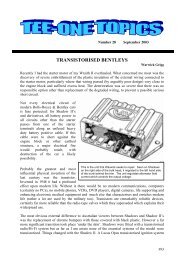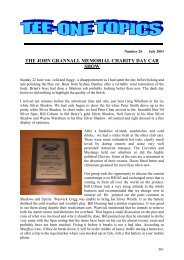WEEP FOR ME - Rolls Royce & Bentley Owners Club - South Africa
WEEP FOR ME - Rolls Royce & Bentley Owners Club - South Africa
WEEP FOR ME - Rolls Royce & Bentley Owners Club - South Africa
Create successful ePaper yourself
Turn your PDF publications into a flip-book with our unique Google optimized e-Paper software.
We all know that carburettors are devices for mixing fuel and air before it is sucked by the<br />
pistons into the engine to do its work. Even the best have been fairly crude contraptions –<br />
equivalent to squirting a garden hose across an exhaust fan. But the eco-terrorists insisted on<br />
minimising the unburnt fuel coming out of the exhaust pipes as well as the soot and various<br />
other nasties which we seem to breath all day. The solution you will have guessed was to inject<br />
a precisely measured squirt of fuel into the ingoing air stream in the hope that it would all be<br />
burnt. And so we at last come to the startling term stoichiometry. Stoichiometry is figuring out<br />
how much stuff you need to make something. For example, if you are going to build 100 cars,<br />
how many wheels do you need? This is a (nonchemical) stoichiometric problem. It can be<br />
solved using Unit Factor Analysis by introducing the wheel/car ratio:<br />
Given the car has four wheels, then<br />
the number of wheels = 100 cars at 4 wheels per car) = 400<br />
If we want to know how many wheel nuts we need, this becomes<br />
nuts = 100 cars (4 wheels/car)(5 nuts/wheel) = 2000 nuts<br />
Just as a factory owner is concerned to have the right number of wheels and nuts available for<br />
the number of cars he is making, the Crewe people tried to work out the quantities of air and<br />
fuel to achieve maximum efficiency with minimum pollutants. If they use more fuel than is<br />
needed, some will be left over. Not only is this wasteful and polluting but too much fuel can<br />
cause a different reaction from the one intended to take place. Factors that have to be taken into<br />
account include the molecular weight of the fuel, its volume at given temperatures and its<br />
temperature at the time of squirt. Are you still with me? I thought not but I hope you have the<br />
general idea. For a novice such as myself the whole system is horrifying yet if these cars are not<br />
to finish up on the local tip, we will need to have at least a basic understanding.<br />
<br />
GETTING UNDER ONE’S GUARD(S) - Wayne Wardman<br />
My Shadow aerial motor recently expired. The fix proved very easy – just removing the front<br />
right wheel and then the stone<br />
guard gave ready access to the<br />
defunct unit. Alas, it also<br />
gave ready access superficial<br />
rust on the outer panel and a<br />
considerable amount of dirt<br />
and small stones. So out came<br />
the vacuum to do its part. I<br />
then applied rust converter to<br />
good effect, followed by my<br />
favourite POR 15.<br />
Applying the logic that the left<br />
side of the car was exposed to<br />
more potential risk I chose to remove the guard on that side and repeat the process. This was<br />
much more difficult. The factory used self tappers with Phillips heads of too small a dimension<br />
385






